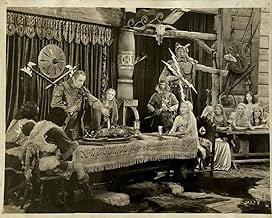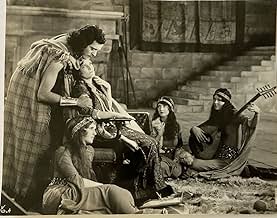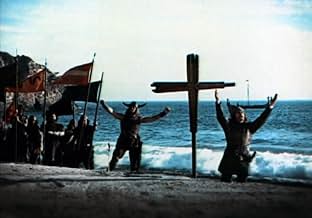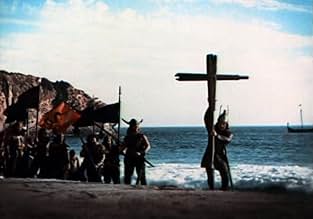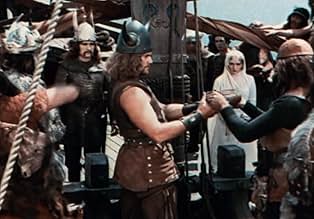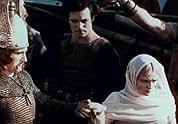Ajouter une intrigue dans votre langueVikings compete for power and the love of a woman.Vikings compete for power and the love of a woman.Vikings compete for power and the love of a woman.
- Réalisation
- Scénario
- Casting principal
Anders Randolf
- Eric the Red
- (as Anders Randolph)
Harry Woods
- Egil
- (as Harry Lewis Woods)
Claire McDowell
- Lady Editha
- (as Claire MacDowell)
Iron Eyes Cody
- Indian
- (non crédité)
Frank Ellis
- Man Who Gives Sword to Alwin
- (non crédité)
Eugene McDonald
- Minor Role
- (non crédité)
Francis McDonald
- Viking Friend of Leif
- (non crédité)
Lon Poff
- Friar Slain by Vikings
- (non crédité)
Angelo Rossitto
- Viking Dwarf
- (non crédité)
Dick Sutherland
- Viking
- (non crédité)
Avis à la une
Hollywood's major studios had used Technicolor Corporation's color technology for a number of years in the 1920s, but had limited its expensive use for just short segments within their feature films. Besides Douglas Fairbanks's 1926 "The Black Pirate," no studio went full bore in adopting the technology for its motion pictures. Technicolor had produced three films on its own to demonstrate its processes, including 1922's "The Toll of the Sea." By 1928, the company was prepared to unveil its latest color system, labeled 'Process 3' film. Among its highlights was the realistic flesh tones of its actors as well as an increase in vibrancy in colors from the previous processes. Added to its wow factor was be an embedded audio track able to play a springy musical soundtrack along with special sound effects. Its end result was the November 1928 release of "The Viking."
Viewers could readily see Technicolor's years of diligent work to get the skin tones just right: actress Pauline Starke as Helga, demonstrates the perfection of the hues with her low-cut costume exposing a ton of flesh. The abundant shots of clear blue skies and the equally aqua ocean capturing a Viking ship's journey to North America were designed to show its richer blues. The narrative was secondary to the visuals. Since the company had to have a plot within the movie, it adapted the script from Ottilie Liljencrantz's 1902 novel 'The Thrall of Leif the Lucky.' Critics complained about the lack of battle scenes, but "The Viking's" purpose was to sell the new vibrant colors to Hollywood and international film studios.
"The Viking's" plot involves Earl of Northumbria (LeRoy Mason) captured in a Viking raid. He's bought by Helga, whose guardian is Leif Ericsson, to be her slave. She falls in love with him despite the coupling being against the Norse code. Several sub-plots unfold, including the influence of Christianity on Leif Ericsson (Donald Crisp) while he and his colleagues butt heads against those who stand with the traditional paganism, a friction that plays into the Vikings' approach to North America.
Irving Thalberg, head of MGM's production, was so enthralled with the look of "The Viking" he convinced his studio to distribute the movie. The film didn't exactly light up the box office, but it did establish a working relationship between Technicolor and MGM, revolutionizing cinema in the coming years.
"The Viking's" conclusion claims the Ericsson colonization of North America took place in what is now Newport, Rhode Island, as evidence by a large tower the Danes erected there. The mysterious "Newport Tower" was later determined to be the remains of a 1650s windmill. But in 1837, a Danish archaeologist suggested it was constructed by the Vikings because he believed a Norse settlement existed from the evidence derived from the nearby Dighton Rock. In fact, Henry Longfellow wrote a poem, 'The Skeleton in Armor,' about the tower's Norse origins. The speculation has since been disproven.
Viewers could readily see Technicolor's years of diligent work to get the skin tones just right: actress Pauline Starke as Helga, demonstrates the perfection of the hues with her low-cut costume exposing a ton of flesh. The abundant shots of clear blue skies and the equally aqua ocean capturing a Viking ship's journey to North America were designed to show its richer blues. The narrative was secondary to the visuals. Since the company had to have a plot within the movie, it adapted the script from Ottilie Liljencrantz's 1902 novel 'The Thrall of Leif the Lucky.' Critics complained about the lack of battle scenes, but "The Viking's" purpose was to sell the new vibrant colors to Hollywood and international film studios.
"The Viking's" plot involves Earl of Northumbria (LeRoy Mason) captured in a Viking raid. He's bought by Helga, whose guardian is Leif Ericsson, to be her slave. She falls in love with him despite the coupling being against the Norse code. Several sub-plots unfold, including the influence of Christianity on Leif Ericsson (Donald Crisp) while he and his colleagues butt heads against those who stand with the traditional paganism, a friction that plays into the Vikings' approach to North America.
Irving Thalberg, head of MGM's production, was so enthralled with the look of "The Viking" he convinced his studio to distribute the movie. The film didn't exactly light up the box office, but it did establish a working relationship between Technicolor and MGM, revolutionizing cinema in the coming years.
"The Viking's" conclusion claims the Ericsson colonization of North America took place in what is now Newport, Rhode Island, as evidence by a large tower the Danes erected there. The mysterious "Newport Tower" was later determined to be the remains of a 1650s windmill. But in 1837, a Danish archaeologist suggested it was constructed by the Vikings because he believed a Norse settlement existed from the evidence derived from the nearby Dighton Rock. In fact, Henry Longfellow wrote a poem, 'The Skeleton in Armor,' about the tower's Norse origins. The speculation has since been disproven.
A handsomely staged silent epic created to showcase the new 2-strip Technicolor process. All the male leads fall for Viking maiden Helga (Pauline Starke, looking exceedingly fetching in her Viking outfits), but there's little doubt about which of them will claim her heart. Worth catching for the sight of a young Donald Crisp looking like a drummer in some early 1970s prog rock band.
There are so many two-strip Technicolor features lost (Laurel and Hardy's The Rogue Song (1930) comes to mind) or just partially intact, that it was a pleasure to see one that seems not only intact (with no black and white inserts) but also as beautiful as originally released. This film is not colorized, as is often done with early black and white films; it was filmed in color, but without the yellow component that was added in the mid 30's that most of us know as Technicolor. As a result, the reds, blues and browns look pretty good, but you will notice the yellows and greens look a bit off color. Still, it is a great example of the process and worth seeing for that reason alone. But there are also some good action sequences that are sure to please lovers of that genre. I also enjoyed the backdrop of the plot; that of Leif Ericsson sailing west to discover America in the 12th century.
"A thousand years ago, long before any white man set foot on the American shore, Viking sea rovers sailed out of the north and down the waterways of the world." "These were men of might, who laughed in the teeth of the tempest, and leaped into battle with a song." "Plundering - ravaging - they raided the coast of Europe - until the whole world trembled at the very name
"THE VIKINGS!"
"Looking out upon the North Sea from the cliffs of England, stood the castle of young Lord Alwin, Earl of Northunbria." Here, good-looking young LeRoy Mason (as Alwin) and his subjects hope their Christian faith will protect them from Viking marauders - but the Lord has other plans for this group (and, you'll know what God has in mind when you see the placement of Christian crosses in North America). The looting and killing Vikings ravage Mr. Mason's English castle. Valuables are taken to Norway, where able-bodied men and women are sold into slavery.
Mason is purchased, for three pieces of silver, by beautiful red-haired "sea rover" Pauline Starke (as Helga Nilsson). The comely Viking lass is obviously buying slave Mason with sexual pleasures in mind, and throws him some lusty looks. Mason proves to be too spirited and independent for Ms. Starke to control, and he is given to guardian Donald Crisp (as Leif Ericsson), the famed Viking leader. A courageous Christian-converted warrior, Mr. Crisp hopes to claim Starke as his bride. But, handsome Harry Lewis Woods (as Egil the Black) is also in love with Starke.
This love quadrangle goes on Crisp's great seafaring adventure to discover, and claim, the "New World" for European conquerors - at the risk of falling off the edge of what they thought might be a very flat Earth. "The Viking" (it should have been titled "The Vikings") is briskly directed by R. William Neill, with moderate action throughout. Either he or Starke should be complimented (or condemned, if you will) for the movement of her character's legs, upon introduction; you don't see this often - and, it's IN COLOR!
Specifically, "Technicolor" - which is this film's mail calling card. While not perfect, the color is strikingly well-preserved. As a bonus, it was made during the "silent film" era, and survives with its original synchronized sound effects score. This level of coloring was painstakingly produced, and was quite expensive. "The Viking" represents a peak in the art of color filmmaking.
******** The Viking (11/2/28) Roy William Neill ~ LeRoy Mason, Pauline Starke, Donald Crisp, Harry Woods
"Looking out upon the North Sea from the cliffs of England, stood the castle of young Lord Alwin, Earl of Northunbria." Here, good-looking young LeRoy Mason (as Alwin) and his subjects hope their Christian faith will protect them from Viking marauders - but the Lord has other plans for this group (and, you'll know what God has in mind when you see the placement of Christian crosses in North America). The looting and killing Vikings ravage Mr. Mason's English castle. Valuables are taken to Norway, where able-bodied men and women are sold into slavery.
Mason is purchased, for three pieces of silver, by beautiful red-haired "sea rover" Pauline Starke (as Helga Nilsson). The comely Viking lass is obviously buying slave Mason with sexual pleasures in mind, and throws him some lusty looks. Mason proves to be too spirited and independent for Ms. Starke to control, and he is given to guardian Donald Crisp (as Leif Ericsson), the famed Viking leader. A courageous Christian-converted warrior, Mr. Crisp hopes to claim Starke as his bride. But, handsome Harry Lewis Woods (as Egil the Black) is also in love with Starke.
This love quadrangle goes on Crisp's great seafaring adventure to discover, and claim, the "New World" for European conquerors - at the risk of falling off the edge of what they thought might be a very flat Earth. "The Viking" (it should have been titled "The Vikings") is briskly directed by R. William Neill, with moderate action throughout. Either he or Starke should be complimented (or condemned, if you will) for the movement of her character's legs, upon introduction; you don't see this often - and, it's IN COLOR!
Specifically, "Technicolor" - which is this film's mail calling card. While not perfect, the color is strikingly well-preserved. As a bonus, it was made during the "silent film" era, and survives with its original synchronized sound effects score. This level of coloring was painstakingly produced, and was quite expensive. "The Viking" represents a peak in the art of color filmmaking.
******** The Viking (11/2/28) Roy William Neill ~ LeRoy Mason, Pauline Starke, Donald Crisp, Harry Woods
THE VIKING of 1928 still appears to be, in a way, a strikingly absorbing picture. Although it seems that any commitment to viewing this movie may be a privilege of some little group of film scholars, claiming that it leaves no impression whatsoever would surely belittle the significance of silent cinema along with its unique appeal. Obviously, it could not stand a chance against many modern 'pseudo-epic adventures' that heap us with cheap effects which, at moments, cross dangerous borderline placing us at risk of being deprived of imagination. With that in mind, its two strip Technicolor effects would merely appear laughable for some but, paradoxically, renewing for others. Yes, some of its awe-inspiring charm that initially contributed to its adventure merit, still remains.
A misleading assumption lies in a viewpoint that solely two strip Technicolor (for which the movie is most famous) makes THE VIKING worth seeing. Of course, it is impossible to miss this point when even mentioning this movie. Nevertheless, what strikes me most about this film is its storytelling and the fact that it evokes the courage of the Vikings no less than their cruelty. Meanwhile, it does not fall into temptation of reducing them to sheer savages from a purely subjective standpoint of 'baddies.' So to say, such an early achievement becomes authentic and, at the same time, gains realistic targets. It is not only executed in the character of Leif Eriksson (Donald Crisp) who travels towards the new shores but, even, in Erik the Red (Anders Randolf), his father. The sophisticated nature of his character is prompted by contrast within him. On the one hand, his axe is used against his political and religious enemies, even his own son when he discovers his new faith. One the other hand, he draws a very humane conclusion in a memorable scene: 'Leif is my son after all.
THE VIKING with no great stars of the time (being an MGM production), contains all the pictorial elements that we find in cinema of any decade. It substantially depicts love, revenge, fight. We have a Northumbria context of Alwin (LeRoy Mason), taken as a slave, we have a beautiful prototype of female warrior, Helga played by Pauline Starke (of course, a blonde beauty as it is a movie about the Vikings after all), we have kings of two opposing policies, we have this eternal conflict between Christian faith (represented by King Olaf of Norway and his followers, including Erik Leifsson) and pagan cults (represented by Erik the Red, Leif's father, the king of Greenland). Predictably, the Christians are depicted as loving, understanding and forgiving while the pagans are cruel. Yet, there is some nobility in both groups (again with reference to a more psychological approach). Their confrontation, however, is one of the most authentic moments of the theme ever found in silent cinema. Finally, we have the theme of new land, promised land, America (yes, long before Columbus) so much appealing to the audiences of the late 1920s.
But the film is no serious stuff and it should never be treated like one. It is, first and foremost, adventure and entertainment. Just to recall some scenes that have truly stood a test of time and are no less entertaining than they must have been in the late 1920s, including the depiction of Greenland, Vikings' feasts (less savage than in 1958 Fleischer's film), love plot between Alwin and Helga, Egil/Alwin vibrant fight. On the subject of Helga, the beautiful warrior blonde, much credit to Pauline Starke's inspiring performance. The idea of such a female character was not new in this period of silent films. We should remember the lost film QUEEN OF SHEBA and the famous chariot race of the queen and princess Vashti. Nevertheless, Starke's portrayal must have occurred revelatory as early as in 1928 combining appeal and authenticity.
I agree with the opinion of those viewers who praise this film and recommend others to seek it out. Perhaps, it is flawed historically; surely, it is no towering entertainment for viewers used to most dazzling spectacles of our decade. Nonetheless, I believe that anyone may find something for themselves in this early Technicolor treasure and find its reasonable running time fruitful and memorable.
A misleading assumption lies in a viewpoint that solely two strip Technicolor (for which the movie is most famous) makes THE VIKING worth seeing. Of course, it is impossible to miss this point when even mentioning this movie. Nevertheless, what strikes me most about this film is its storytelling and the fact that it evokes the courage of the Vikings no less than their cruelty. Meanwhile, it does not fall into temptation of reducing them to sheer savages from a purely subjective standpoint of 'baddies.' So to say, such an early achievement becomes authentic and, at the same time, gains realistic targets. It is not only executed in the character of Leif Eriksson (Donald Crisp) who travels towards the new shores but, even, in Erik the Red (Anders Randolf), his father. The sophisticated nature of his character is prompted by contrast within him. On the one hand, his axe is used against his political and religious enemies, even his own son when he discovers his new faith. One the other hand, he draws a very humane conclusion in a memorable scene: 'Leif is my son after all.
THE VIKING with no great stars of the time (being an MGM production), contains all the pictorial elements that we find in cinema of any decade. It substantially depicts love, revenge, fight. We have a Northumbria context of Alwin (LeRoy Mason), taken as a slave, we have a beautiful prototype of female warrior, Helga played by Pauline Starke (of course, a blonde beauty as it is a movie about the Vikings after all), we have kings of two opposing policies, we have this eternal conflict between Christian faith (represented by King Olaf of Norway and his followers, including Erik Leifsson) and pagan cults (represented by Erik the Red, Leif's father, the king of Greenland). Predictably, the Christians are depicted as loving, understanding and forgiving while the pagans are cruel. Yet, there is some nobility in both groups (again with reference to a more psychological approach). Their confrontation, however, is one of the most authentic moments of the theme ever found in silent cinema. Finally, we have the theme of new land, promised land, America (yes, long before Columbus) so much appealing to the audiences of the late 1920s.
But the film is no serious stuff and it should never be treated like one. It is, first and foremost, adventure and entertainment. Just to recall some scenes that have truly stood a test of time and are no less entertaining than they must have been in the late 1920s, including the depiction of Greenland, Vikings' feasts (less savage than in 1958 Fleischer's film), love plot between Alwin and Helga, Egil/Alwin vibrant fight. On the subject of Helga, the beautiful warrior blonde, much credit to Pauline Starke's inspiring performance. The idea of such a female character was not new in this period of silent films. We should remember the lost film QUEEN OF SHEBA and the famous chariot race of the queen and princess Vashti. Nevertheless, Starke's portrayal must have occurred revelatory as early as in 1928 combining appeal and authenticity.
I agree with the opinion of those viewers who praise this film and recommend others to seek it out. Perhaps, it is flawed historically; surely, it is no towering entertainment for viewers used to most dazzling spectacles of our decade. Nonetheless, I believe that anyone may find something for themselves in this early Technicolor treasure and find its reasonable running time fruitful and memorable.
Le saviez-vous
- AnecdotesWhen the film opened at the Embassy Theatre in New York City on November 28, 1928, it was still silent and was accompanied by a live orchestral accompaniment. In December 1928 a musical score was recorded, sound-on-disc, and this version was distributed by Metro-Goldwyn-Mayer (MGM) in 1929.
- GaffesViking women neither shaved their underarms nor wore the strapless bustiers.
- Citations
Title Card: A thousand years ago, long before any white man set foot on the American shore, Viking sea rovers sailed out of the north and down the waterways of the world. These were men of might, who laughed in the teeth of the tempest, and leaped into battle with a song. Plundering - ravaging - they raided the coast of Europe - until the whole world trembled at the very name - THE VIKING.
- Crédits fousThe title card bills the three stars in the order Pauline Starke [top billing], Donald Crisp [second billing], and Le Roy Mason [third billing]. But the opening credits end with "The Players" listed in the order: first "Leif Erickson ... Donald Crisp," second "Helga . . . Pauline Starke, third "Alwin . . . Le Roy Mason," etc. The characters appear on screen in the order Alwin, Helga, and Leif Erickson.
- ConnexionsFeatured in New England Legends: Creepy Christmas (2019)
Meilleurs choix
Connectez-vous pour évaluer et suivre la liste de favoris afin de recevoir des recommandations personnalisées
- How long is The Viking?Alimenté par Alexa
Détails
Box-office
- Budget
- 325 000 $US (estimé)
- Durée
- 1h 30min(90 min)
Contribuer à cette page
Suggérer une modification ou ajouter du contenu manquant


